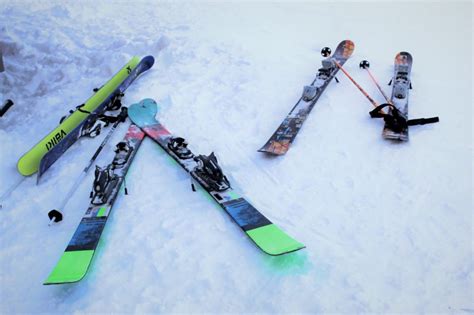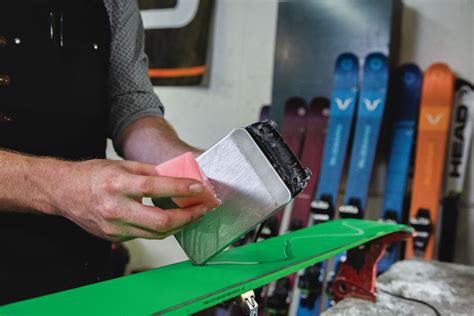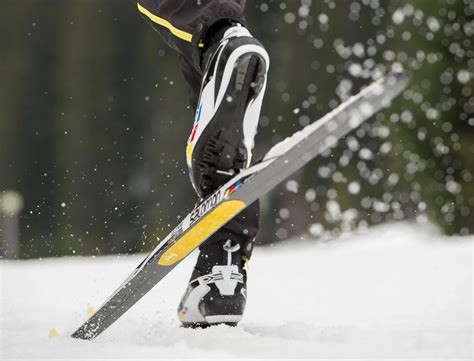Do New Skis Need To Be Waxed?⏬

Explore whether new skis require waxing for downhill, cross-country, or before use, and if they come factory-waxed. Essential tips for peak performance.As the snow blankets the slopes and the season’s call beckons ski enthusiasts to the mountains, one question frequently slides to the forefront of conversations among beginners and seasoned pros alike: “Do new skis need to be waxed?” This seemingly simple inquiry is anything but, with considerations varying based on the type of skiing and the ski manufacturing process itself. Whether you’re carving down alpine slopes with downhill skis or gliding over the serene landscape on cross-country skis, understanding the nuances of ski preparation can be the difference between a good day and a great day on the snow. Through this blog post, we’ll glide over the surface of this topic, exploring why and when to wax new skis, if they come ready to use straight from the factory, and how often we should be maintaining our skis for optimum performance. Strap on your boots and grab your poles; it’s time to dive into the slick world of ski waxing.
Do Brand New Skis Need To Be Waxed
When it comes to brand new skis, there is often a misconception that they are ready to hit the slopes straight out of the box; however, that is not always the case. It is crucial for enthusiasts to understand that, in order to ensure optimal performance and longevity of their skis, a proper waxing may be necessary even when they are brand new.
The process of waxing skis is essential as it serves multiple functions — from reducing friction between the ski and the snow, which results in a smoother ride, to protecting the base from damage, and also improving the overall control that a skier has over their equipment. Manufacturers often apply a layer of wax before shipping, but this does not always guarantee the skis are slope-ready.
It’s worth noting that downhill and cross-country skis have different needs when it comes to waxing. Downhill skis generally require a universal or temperature-specific wax to be applied more frequently, while cross-country skis might demand special attention depending on whether they are classic style or skate skis, as the latter often needs glide wax on the tips and tails and grip wax on the midsection.
Moreover, while some skis do come pre-waxed from the factory, it is often a light coat that is meant to protect them during transport and storage rather than for actual use on slopes. It’s advisable for ski owners to either learn how to properly wax their skis or take them to a professional technician for a thorough service. To provide a clearer perspective, the following table showcases the typical waxing needs based on ski type and usage:
| Ski Type | Initial Waxing | Maintenance Waxing Frequency |
|---|---|---|
| Downhill Skis | Strongly Recommended | Every 1-6 days of skiing |
| Cross Country Skis (Classic) | Strongly Recommended | As needed, varies with conditions |
| Cross Country Skis (Skate) | Strongly Recommended | Every 1-5 days of skiing |
In conclusion, while the degree and frequency of waxing may vary, the consensus remains the same — brand new skis indeed benefit from being waxed before their inaugural run down the mountain. This not only enhances the skiing experience but also contributes to the upkeep of your valuable winter sports gear.
Do New Downhill Skis Need To Be Waxed
When it comes to hitting the slopes with brand new downhill skis, enthusiasts and experts often encounter the question of whether these skis need to be waxed before their first use. Despite the fact that new skis typically come with a factory wax, it is generally recommended to apply an additional layer of wax tailored to the specific conditions they will be used in. This not only enhances the performance of the skis on the snow but also plays a critical role in protecting the base material over time.
One of the primary reasons for waxing new downhill skis is to ensure that they provide a smooth and responsive ride. Waxing can fill minute imperfections in the base, leading to better glide, increased speed, and more precise control. Moreover, it is important to acknowledge that different types of snow conditions require specific waxes to optimize performance—factory-applied waxes may not be suited for the temperature and type of snow at your local ski area.
New skis are subject to dryness and oxidation if left unwaxed for an extended period. This emphasizes the need for protective waxing to maintain the integrity of the base material. A well-waxed ski can better repel moisture, which reduces the likelihood of the base drying out and ultimately extends the lifespan of the skis. Below are some key points to consider:
- Factory Wax: While new skis often have a protective layer of wax applied, this is usually a light coating that serves more for protection during transportation and storage rather than optimal performance.
- Performance Waxing: A specialized wax job, tailored to current snow conditions and temperature, can drastically enhance the ride, giving the skier a more enjoyable experience on the slopes.
- Base Protection: Regular waxing creates a barrier against the elements, preserving the ski base against abrasive snow and contaminants like dirt.
For those who are unsure about the correct waxing procedures or the types of wax to use, it’s best to consult a professional at your local ski shop. Alternatively, one can consider learning the waxing process, which can be a rewarding aspect of ski maintenance. In conclusion, although new downhill skis may come pre-waxed from the factory, waxing them again before use is a wise choice for anyone looking to ensure peak performance and longevity of their equipment.
| Consideration | Detail |
|---|---|
| Factory Wax | Often a light coating, not suited for all snow conditions |
| Performance Benefits | Enhanced glide, speed, control tailored to specific conditions |
| Base Protection | Prevents dryness and oxidation, prolonging the life of the skis |
Do New Cross Country Skis Need Wax
When venturing into the serene trails of cross-country skiing, one may ponder whether new cross-country skis require waxing before their inaugural glide across the snow. The necessity of wax for these skis is not merely a matter of routine maintenance; it is an essential aspect that enhances performance and protects the integrity of the skis. Understanding the specifics of why and how to wax your skis can remarkably improve your skiing experience.
Most new cross-country skis arrive from the factory with a layer of wax applied, but this is often a generic wax that serves as protection during transportation and storage, rather than being optimized for performance. Hence, applying the appropriate wax, tailored to the current snow conditions and temperature, can significantly affect the glide and grip of your skis. Systematic waxing also extends the lifespan of the ski base, ensuring that enthusiasts can enjoy the beautiful winter landscape for seasons to come.
There are different types of wax for varying conditions: glide waxes for the tips and tails, and kick waxes for the grip section beneath your foot if you are using classic waxable skis. However, for those with waxless skis featuring a patterned grip section, glide waxing the correct areas still remains a relevant step in preparation. Skiers should be cognizant of selecting the right type of wax to accommodate the temperature and snow type they’ll be navigating through on their journey.
To wax your new cross-country skis, the following steps should be meticulously employed:
- Begin by cleaning the base of your skis to remove old wax and dirt, ensuring a clean surface for the new wax to adhere to.
- Choose the proper wax based on the current snow conditions and temperature, as this choice will influence the performance of your ski.
- Apply glide wax to the tip and tail sections of your ski, taking care to leave the middle section free for kick wax if you have classic skis, or simply ensuring it remains untouched for waxless skis.
- When applying kick wax, a thin, even layer should be spread onto the grip zone for classic skis to enhance traction during the kick phase.
To elucidate the process further, a concise table can aid avid skiers in determining the type of wax to use:
| Temperature | Snow Type | Glide Wax | Kick Wax (Classic Skis) |
|---|---|---|---|
| Below 0°C | Cold, Fresh Snow | Blue Wax | Purple Special Wax |
| 0°C to -5°C | Transformed Snow | Red Wax | Red Special Wax |
| Above 0°C | Wet, Icy Snow | Yellow Wax | Universal Klister |
In conclusion, while new cross-country skis may come factory-waxed, it is a recommended practice to apply a specialized wax before initial use. Doing so ensures both enhanced performance and preservation which serious skiers deeply appreciate. Regular waxing transforms an ordinary cross-country skiing experience into a much more efficient and pleasurable pursuit, helping skiers forge an even deeper bond with the wintery world they love to explore.
Do New Skis Need To Be Waxed Before Using
Embarking on a new snow adventure calls for a detailed consideration of equipment maintenance, particularly when it comes to new skis. A common inquiry amongst winter sports enthusiasts is whether brand new skis require waxing before their initial descent down the slopes. Indeed, this is a pivotal aspect of ski preparation that warrants a comprehensive understanding.
When addressing the question of Do new downhill skis need to be waxed or Do new cross country skis need wax, the answer can often depend on the manufacturing process of the skis in question. New skis typically arrive with a factory-applied wax, but this is generally a light protective coating intended for storage and shipment rather than optimal glide on snow.
The process of waxing is not purely for the sake of maintenance but also plays a crucial role in performance. By examining whether new skis come waxed from the factory, one can discern that the pre-applied layer may not be adequate for specific snow conditions or for the best possible performance. Hence, a proper wax job tailored to the environmental factors can significantly enhance the skiing experience.
Regarding the frequency of waxing, some might question, Do new skis need to be waxed every time they are used? While not every single use necessitates waxing, recognizing the importance of regular wax application to protect and maintain the ski’s base cannot be overstated. Ski bases are designed to absorb wax, reducing friction for a smoother ride over the snow. Consequently, a lack thereof can lead to base damage over time.
To illustrate the general consensus among seasoned skiers and technicians, consider the following points in a table format:
| Aspect | Consideration |
|---|---|
| Factory Wax | Light protective layer, often insufficient for actual slope conditions. |
| Waxing Before Use | Recommended to tailor to snow conditions and ensure optimal performance. |
| Wax Type | Different waxes available for varying temperatures and snow types. |
| Frequency of Waxing | Regular waxing advised based on usage and conditions, not necessarily every usage. |
In conclusion, waxing new skis before using them is a step that should not be overlooked by those aiming to get the most out of their skiing experience. Despite the fact that skis may arrive with a factory wax, it’s optimal to apply a fresh wax job matching the skier’s needs and the environmental conditions, thus ensuring protection and an enhanced riding experience.
Do New Skis Come Waxed From The Factory
When it comes to preparing for the slopes, many enthusiasts question whether their brand new skis are ready for action straight out of the box. A pertinent aspect of this preparation is waxing, specifically, whether new skis come waxed from the factory. This detail is crucial as it can impact the performance and lifespan of the skis. The answer isn’t uniform across all brands or types of skis, which adds to the complexities that skiers might face.
Typically, most new skis do come with a layer of wax applied during the manufacturing process. This wax, however, is often a light protective coating aimed at safeguarding the skis during transit and storage, rather than optimized for performance on the slopes. Therefore, while your skis might appear shiny and ready to go, this factory-applied wax may not be ideal for the conditions you’ll encounter or for providing the best gliding capabilities.
Moreover, the type of skiing you indulge in also plays a role in the waxing needs. For instance, new downhill skis and new cross country skis might have different requirements based on their intended use and the conditions they’re designed for. Downhill skis, being used on more varied and often icier terrains, might benefit from an immediate customized waxing, while cross-country skis could rely more on the factory wax, at least for the first few outings.
The frequency of waxing new skis is another subject of debate. Considering whether new skis need to be waxed every time before hitting the slopes can lead to different practices among skiers. Some may opt for a routine of waxing after every few trips to maintain optimal performance, while others may judge the necessity based on changing snow conditions and the performance they are experiencing.
In conclusion, while new skis generally come with a layer of factory-applied wax, it is often recommended to apply a fresh wax that is suitable for the specific conditions one plans to ski in. Understanding the nature of the factory wax and the unique requirements of your particular skiing style can greatly enhance your skiing experience. Below is a table summarizing the waxing guidelines for new skis:
| Type of Ski | Factory Wax | Recommendation |
|---|---|---|
| Downhill Skis | Light protective coating | Custom waxing recommended |
| Cross Country Skis | Light protective coating | May use factory wax initially |
Do New Skis Need To Be Waxed Every Time
When addressing the question of whether new skis need to be waxed every time they hit the slopes, it is imperative to understand the role that wax plays in the maintenance and performance of skis. Waxing is not merely a one-time affair post-purchase but a crucial aspect of ski upkeep that ensures optimal glide, protection from the elements, and longevity of your equipment. Ski enthusiasts may ponder on the frequency and the necessity of this practice for newly acquired skis.
Firstly, the factory wax applied to new skis is often a general coat, meant to protect the ski during shipment and storage rather than optimized for performance. This initial layer of wax caters to basic protection but may not be sufficient for specific snow conditions, temperatures, or for achieving the best friction reduction qualities that seasoned skiers crave. Therefore, personalizing the wax to fit the skiing conditions is a step not to be underestimated.
Furthermore, considering different types of skis, for instance, brand new downhill skis versus cross-country skis, there is a disparity in waxing needs. Downhill skis often benefit from regular waxing before use to ensure they maintain their swift glide down the slopes. On the other hand, with the advent of waxless base patterns for new cross-country skis, frequent waxing may not be necessary except for the tips and tails of the skis or the inclusion of grip wax for classic styles.
In the realm of ski maintenance and performance, it is generally recommended to apply a fresh coat of wax after every few days of skiing. The exact frequency, however, hinges on a variety of factors including but not limited to snow conditions, ski usage intensity, personal preferences, and the specific requirements of different types of skis. As an invaluable tip for avid skiers, maintaining a regular waxing schedule for new skis enhances performance and prolongs the life span of the gear.
It is worth mentioning that adherence to consistent waxing offers numerous benefits outlined in a table below:
| Benefits of Regular Waxing | Description |
|---|---|
| Improved Glide | Waxing reduces friction between the ski base and the snow, providing a smoother and faster glide down the slopes. |
| Enhanced Durability | Regular waxing forms a protective layer that helps shield the ski base from abrasions, dents, and environmental damage. |
| Better Control | A well-waxed ski interacts more predictably with snow conditions, allowing for improved handling and control. |
| Optimal Performance | The ski’s performance is at its peak when the right type of wax is used for the current snow conditions and temperature. |
- Ultimately, new skis should indeed be waxed periodically to ensure they deliver the best possible performance each time they are used.
- Whether your skis are straight from the factory, or have seen a few runs, establishing and adhering to a comprehensive waxing routine is essential for any serious skier.
Frequently Asked Questions
Do new skis come pre-waxed from the factory?
Yes, most new skis come with a light factory wax applied. This wax is generally for protection and storage, and not optimized for skiing performance.
Why is it important to wax new skis before hitting the slopes?
Waxing new skis ensures they provide optimal glide and protection against the snow conditions you’ll be skiing in. Factory wax may not be suitable for the specific temperature and snow type at the ski resort.
Can I wax my skis at home, or should I take them to a professional?
You can wax your skis at home with the right equipment and knowledge. However, a professional ski technician will ensure a precise and high-quality wax, which might be especially valuable for brand new skis.
How often should I wax my skis after the initial wax?
The frequency of waxing can depend on various factors like snow conditions, ski usage, and personal performance expectations. A general rule is to wax your skis every 5-6 days of skiing, or when you notice a decrease in glide.
Does the type of wax matter when waxing new skis?
Absolutely, the type of wax should be matched to the temperature of the snow you will be skiing on. Universal waxes are good for a broad range of temperatures, but temperature-specific waxes provide the best performance.
Is hot waxing better than rub-on wax for new skis?
Hot waxing tends to provide a deeper and longer-lasting treatment for your skis, as the wax penetrates the base of the ski better than rub-on wax. For new skis, hot waxing is recommended for a thorough base preparation.
What are the risks of not waxing new skis before using them?
Not waxing new skis may lead to suboptimal performance, including reduced glide and control. It also exposes the bases to more damage from ice, rocks, and snow friction, potentially shortening the lifespan of your skis.








